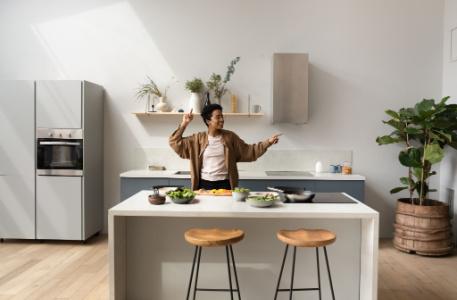
How to Design the Ideal Kitchen Island for Your Home
Whether searching for a home or remodeling the one where you live, it’s a safe bet that a kitchen with an island is high on your priority list. While islands aren’t new features, they’ve grown in importance and often in size.
According to Houzz’s 2022 Kitchen Trends, nearly 40 percent of homeowners making space for an island reported that their remodeling project included an island more than 7 feet long.
Today’s islands frequently serve multiple purposes beyond preparing food. They’re often spaces to gather with friends, do homework, or share a casual family meal.
If you’re planning to remodel your kitchen and want to include an island, make sure it checks all the essential boxes!
1. Size.
Islands range from small, compact workstations to large and lavish kitchen features. Some kitchen designs even include double islands.
One of the most significant factors in determining the best dimensions for your island is making sure you don’t create pinch points—spots where people feel crowded trying to move within the kitchen.
In most cases, 48 inches of space around the island will allow two people to pass, even if a cabinet or dishwasher door is open.
If your kitchen layout doesn’t accommodate any size island, consider creating a peninsula instead. It might be an excellent option that can include many similar features.
2. Integrated features.
With careful planning, islands can be ideal locations for essential kitchen appliances, equipment, and other features.
For example, if you’ve decided to position your main sink on an island, be sure there’s room for your dishwasher on either side of the sink.
Likewise, if your island will be dedicated to prepping food, you may want convenient access to cutting boards, knives, trash, compost, and recycling bins.
Pet lovers may want to include a feeding station for dogs or cats.
3. Seating.
Since kitchen islands are natural gathering spots, many homeowners want to include seating.
While countertop-height bar stools are most common, you may prefer a two-tiered design that positions a 42-inch countertop and taller seats next to a traditional 36-inch countertop workspace. Or, a 36-inch countertop paired with 30-inch table-height seating may be ideal.
Be sure to consider how much space you’ll need for each bar stool—and the people sitting on them. Most bar stools are 17-18 inches wide, although dimensions can vary substantially. Ideally, you want enough space between the seats to provide comfortable elbow room.
Consider seating depth, too. To provide adequate legroom, plan on 12-18 inches of overhang. If it’s important to slide the stools completely under the countertop when not in use, you may need a deeper overhang.
To facilitate conversations between family members or guests, try to use more than one side of your island for seating.
4. Lighting.
Pendant lights are popular choices for kitchen islands. Beyond personal style preferences, also consider whether you prefer having the light directed downward onto the countertop to provide task lighting or outward into the room to add general ambient light.
Solid surface light fixtures like metal or glass are usually easier to keep clean in a kitchen than fabric shades.
But don’t feel limited to pendant lights. Long, linear fixtures, for example, can also work well for island lighting.
5. Outlets.
Local building codes often require at least one electrical outlet on kitchen islands. But, even if outlets aren’t mandatory, don’t skip this feature without carefully considering whether you’ll want the convenience of powering small appliances like a blender or having an outlet handy to charge phones.
Also, consider where to position any outlets. For example, suppose your island is topped with a continuous countertop surface. In that case, it’s usually preferable to tuck an outlet into the finished side of a cabinet a couple of inches below the countertop.
If the island has two different heights, it’s often easier to hide outlets in the small vertical wall connecting the lower and upper countertop surfaces.
6. Cabinets and countertops.
Do you want your island to match the rest of the kitchen, or do you prefer a mix-and-match look? Islands provide an opportunity to add visual interest by selecting different but compatible materials.
In terms of countertop options, quartz remains the most popular choice, primarily because it’s highly durable and easy to maintain. But you may want to make a more dramatic statement on the island with natural stone like quartzite or other unique options.
Remember that the material you select could limit some of your design alternatives. For example, most natural stone countertops come in slabs measuring 4x10 feet. That means you’d have to include a seam in a 5-by-7-foot single-height island.
Alternatively, you could modify your design to include two narrower surfaces at different levels or select another countertop material available in larger widths.
